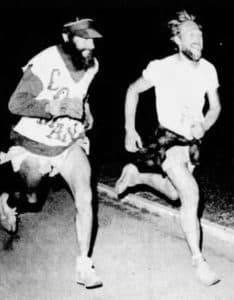Miscellaneous
By Davy Crockett The 1978 Western States 100 was the second year the race was held. Six years earlier, seven soldiers from Fort Riley Kansas proved that the horse trail could be conquered on foot, and they were awarded with the “First Finishers on Foot” trophy by Western States founder, Wendell Robie (1895-1984). Two years later, in 1974, Gordy Ainsleigh surprised his horse endurance peers when he ran the 89-mile Western States Trail in less than 24 hours. Three years later, in 1977, Robie decided it was time to organize a foot race on his trail. The inaugural race was hastily put together by a few volunteers who had horse endurance race experience but did not have much experience with human running races (see episode 71). The first race was mostly self-supported and fairly dangerous in very high temperatures. They were lucky that there were no serious heat-related emergencies, and only three of the 16 starters finished. Planning for the 1978 Western States 100 Run became more serious and was much better organized. The 1978 race should be considered as the first fully supported Western States Endurance Run which gave all entrants a good chance to finish. Please help support this podcast. I can offer a 25% discount on Ultrarunning Magazine subscriptions and renewals. Some proceeds help fund this website. Visit https://ultrarunninghistory.com/mag Subscribe or renew today with this link. Gang of Four - Curt and Mo Sproul, Phil and Shannon Gardner A Western States Endurance Run Board of Governors was formally organized by race founder, Wendall Robie. The four members, affectionately called “The Gang of Four,” were all horse endurance riders, still learning what ultrarunning was all about. They were Phillip (1944-) and Shannon Gardner (1947-), and Curtis (1949-) and Marion “Mo” Sproul (1952-). Curt served as the president. Even though they still had much to learn about the running sport, they blazed ahead into history to put together a mountain ultra that many other key ultras would mimic. Joe Sloan, age 44, an experienced runner and public relations specialist from Auburn who ran in the Boston Marathon that year claimed that he was also on the new Board of Governors that year. Gardner's Western States office at the bank Because of difficulties experienced in 1977 with both runners and horses on the same trail, especially with single-track sections, the run was moved to the month before the Tevis Cup (Western States Trail Ride), on June 24, 1978. Shannon Gardner worked at Robie’s bank, Heart Federal Savings and Loan, made contacts to get the word out, and fielded calls from interested runners. Marketing Western States 100 Marketing for the Run was mostly by word-of-mouth, but in a 1978 Runner’s World magazine, an advertisement was included that read: “Western States 100-mile Endurance Run. An experience only for ultramarathon veterans. Course: rugged, uncertified over mountains, through streams, with snakes and bears. All entries must pass physical exam. No one under 18. 30-hour time limit.” The entrant's fee was $10. Mo Sproul explained, “We did try to make our publications as top-drawer as they could be, so that we presented an organized face to the outside world, even though a lot of it was being done in my kitchen or at Shannon’s desk.” The 1978 entry form warned, “Do not enter unless in excellent physical condition, have run marathon distances over 26 miles, and have had a complete physical examination, preferably including a stress electrocardiogram.” The Gordy Ainsleigh myth begins The race organizers started to prop up the legend of Gordy Ainsleigh and numerous news articles erroneously stated that he was the first to cover the course on foot. They purposely decided to make no mention of the soldiers from Fort Riley, Kansas who completed the course on foot during the Tevis Cup in 1972 and were given the "First Finisher on Foot" trophy from Wendell Robie.

